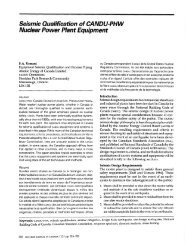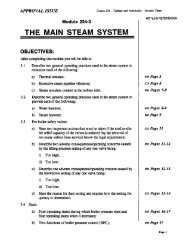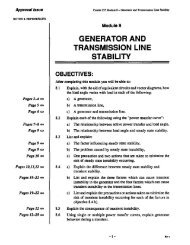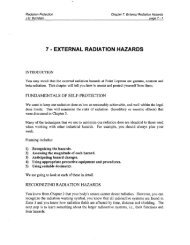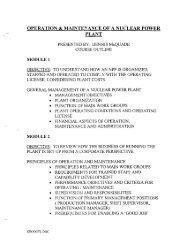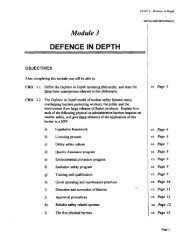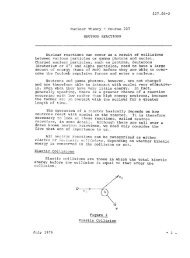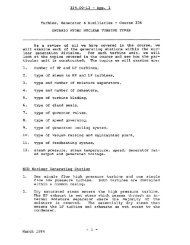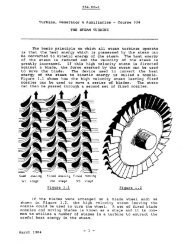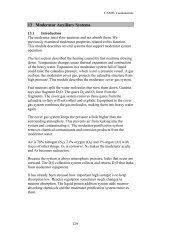234.00-3 Turbine, Generator & Auxiliaries - Course 234 ... - Canteach
234.00-3 Turbine, Generator & Auxiliaries - Course 234 ... - Canteach
234.00-3 Turbine, Generator & Auxiliaries - Course 234 ... - Canteach
You also want an ePaper? Increase the reach of your titles
YUMPU automatically turns print PDFs into web optimized ePapers that Google loves.
<strong><strong>234</strong>.00</strong>-3<br />
Figure 3.1 shows the basic hydraulic relay and actuator<br />
associated with a governor steam valve. The governor steam<br />
valve is opened by increasing the hydraulic pressure on the<br />
underside of the actuator piston and compressing the spring:<br />
the governor steam valve is shut by draining oil from the underside<br />
of the actuator piston and allowing the spring to expand<br />
and force the valve shut. The control relay is positioned<br />
either mechanically or electrically to supply fluid<br />
to, or drain fluid from, the actuator. Mechanical or electrical<br />
feedback is provided to position the control relay to<br />
neutral and stop the flow of fluid when the governor steam<br />
valve has moved to the desired position.<br />
There are two hydraulic fluids which are used for governor<br />
steam valve actuation:<br />
(a) turbine lubricating oil, and<br />
(b) a phosphate ester, fire resistant fluid.<br />
<strong>Turbine</strong> lubricating oil has been used for many years as<br />
the hydraulic fluid for governor steam valve actuation. Lubricating<br />
oil is readily available and does not require a separate<br />
pumping system nor a separate purifying system, when<br />
used as a control fluid. In addition, if the lubricating oil<br />
system should fail, the governor steam valves will shut since<br />
it is lubricating oil which is holding them open. Lubricating<br />
oi 1 has several disadvantages , although they were not<br />
serious enough to preclude its use as a control fluid:<br />
1. The control fluid has<br />
lUbrication. That is,<br />
properties as a control<br />
ties as a lUbricant.<br />
to be compatible with bearing<br />
the fluid is chosen not for its<br />
fluid but rather for its proper-<br />
2. The lubricating oil is subject to all manner of contamination<br />
which tends to degrade its purity. These include:<br />
fibres, water, chlorides, dirt, rust and sludge.<br />
The principle disadvantage of using lubricating oil, as<br />
a control fluid, did not become apparent until turbines became<br />
fairly large.<br />
The larger the steam flow handled by turbines, the larger<br />
the governor steam valves had to be and the greater the<br />
force necessary to move the valves at the required speeds.<br />
Since Force = (Pressure) (Area), the larger force couId be<br />
gained in one of two ways:<br />
1. increase the pressure of the control oil, or<br />
2. make the actuators larger.<br />
- 2 -




